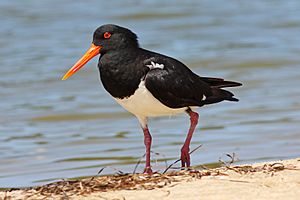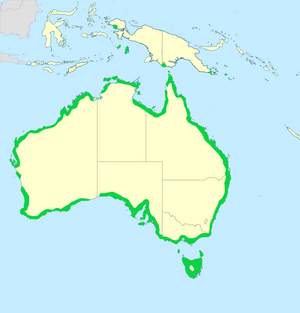Pied oystercatcher facts for kids
Quick facts for kids Pied oystercatcher |
|
|---|---|
 |
|
| An adult walking along a coastline in Victoria – notice its bright orange-red beak! | |
| Conservation status | |
| Scientific classification | |
| Genus: |
Haematopus
|
| Species: |
longirostris
|
 |
|
| Where pied oystercatchers live in Australia and nearby islands (green area). | |
The pied oystercatcher (Haematopus longirostris) is a special type of oystercatcher bird. It's a wading bird, which means it likes to walk in shallow water. You can find it living along the coastline of Australia. There's a similar bird called the South Island pied oystercatcher (H. finschi) that lives in New Zealand.
Contents
What Does a Pied Oystercatcher Look Like?
The name "oystercatcher" can be a bit confusing for this bird. That's because they usually don't eat oysters! Oysters are mostly found on rocky shores. Pied oystercatchers prefer sandy beaches. There, they mostly eat bivalve molluscs. These are shellfish with two shells, like clams or mussels. The birds use their special beaks to open them up.
You can easily spot this Australian bird. It has a bright orange-red beak that is about 5 to 8 centimeters long. Its legs are slender and pink. Its body is covered in black and white feathers. When it flies, you can see a white stripe on its wings. Male and female pied oystercatchers look very similar. However, males usually have a slightly shorter and wider beak.
Pied Oystercatcher Habits and Life

Pied oystercatchers mainly eat bivalve molluscs. But they also eat other small invertebrates, which are animals without a backbone. The ways they open the shells of molluscs can be very different. Scientists think these techniques are learned behaviors. This means they learn from other birds, not just by instinct.
These birds make their nests in shallow dips in the ground. They choose open areas close to the shore. A typical clutch (group of eggs) has 2 to 3 eggs. Each pair of oystercatchers protects their nesting area. They often use the same spot year after year. Like the gulls that share the shore, oystercatchers will work together. They will mob, or attack, anything they see as a threat.
Are Pied Oystercatchers Safe? Conservation Status
The pied oystercatcher is generally considered 'secure' in Australia. This means there are enough of them, and they are not at high risk. However, in New South Wales, Australia, this bird is listed as 'endangered'. This means they are at a higher risk of disappearing in that specific area.
See also
 In Spanish: Ostrero pío australiano para niños
In Spanish: Ostrero pío australiano para niños


